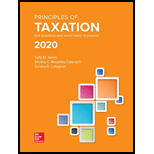
Explain the way tax payments differ from other payments that people or organizations make to governmental agencies.
Explanation of Solution
The Tax: As defined by IRS the tax is “an enforced contribution, exacted pursuant to legislative authority in the exercise of the taxing power, and imposed and collected for the purpose of raising revenue to be used for public or governmental purposes. Taxes are not payments for some special privilege granted or service rendered and are, therefore, distinguishable from various other charges imposed for particular purposes under particular powers or functions of government.”
As defined, the tax payments are mandatory payments from all eligible taxpayers mobilizing revenue for the government, for its use for the public as a whole. Unlike any fines and penalties that are punishable act by the government, tax payments are made to meet the tax obligations by the taxpayers. Unlike fess, like driving license fee or stamp duty, the tax payments cannot be attributed to any specific cause or benefit. Tax payments differs from fees and other government payment, as it is compulsory and mandatory for the taxpayer to pay their tax due in time.
Want to see more full solutions like this?
Chapter 1 Solutions
Principles of Taxation for Business and Investment Planning 2020 Edition
- Noyan Carter's weekly gross earnings for the week ending August 15th were $3,200, and his federal income tax withholding was $650. Assuming the Social Security rate is 6.2% and Medicare is 1.5% of all earnings, What is Carter's net pay?arrow_forwardSuppose that Cullumber Automated Retail Company has the following inventory data: Nov. 1 Inventory 23 units @ $4.70 each 8 Purchase 94 units @ $5.05 each 17 Purchase 47 units @ $4.90 each 25 Purchase 70 units @ $5.10 each The company uses a periodic inventory system. A physical count of merchandise inventory on November 30 reveals that there are 78 units on hand. Cost of goods sold under LIFO rounded to the nearest dollar is $386. $396. $784. $774.arrow_forwardOn May 1, Sandhill Company had beginning inventory consisting of 360 units with a unit cost of $8. During May, the company purchased inventory as follows: 720 units at $8 1080 units at $9 The company sold 1800 units during the month for $14 per unit. Sandhill uses the average-cost method. Assuming that a periodic inventory system is used, the value of Sandhill's inventory at May 31 is (Round average cost per unit to 2 decimal places, e.g. 12.52.) ○ $3240 ○ $18360 ○ $3060 ○ $2880arrow_forward
- Suppose that Sandhill Trading Post has the following inventory data: July 1 Beginning inventory 46 units at $23 $1058 7 Purchases 162 units at $24 3888 22 Purchases 23 units at $26 598 $5544 The company uses a periodic inventory system. A physical count of merchandise inventory on July 31 reveals that there are 58 units on hand. Using the LIFO inventory method, the amount allocated to cost of goods sold for July is ○ $4198. ○ $4036. ○ $3932. ○ $4106.arrow_forwardSuppose that Sandhill Trading Post has the following inventory data: July 1 Beginning inventory 46 units at $23 $1058 7 Purchases 162 units at $24 3888 22 Purchases 23 units at $26 598 $5544 The company uses a periodic inventory system. A physical count of merchandise inventory on July 31 reveals that there are 58 units on hand. Using the LIFO inventory method, the amount allocated to cost of goods sold for July is ○ $4198. ○ $4036. ○ $3932. ○ $4106.arrow_forwardSuppose that Ivanhoe Depot Inc. has the following inventory data: July 1 Beginning inventory 24 units at $19 $456 7 Purchases 84 units at $20 1680 22 Purchases 12 units at $22 264 $2400 The company uses a periodic inventory system. A physical count of merchandise inventory on July 31 reveals that there are 40 units on hand. Using the FIFO inventory method, the amount allocated to ending inventory for July is ○ $824. 000 $800. ○ $880. ○ $776.arrow_forward
 Individual Income TaxesAccountingISBN:9780357109731Author:HoffmanPublisher:CENGAGE LEARNING - CONSIGNMENT
Individual Income TaxesAccountingISBN:9780357109731Author:HoffmanPublisher:CENGAGE LEARNING - CONSIGNMENT EBK CONTEMPORARY FINANCIAL MANAGEMENTFinanceISBN:9781337514835Author:MOYERPublisher:CENGAGE LEARNING - CONSIGNMENT
EBK CONTEMPORARY FINANCIAL MANAGEMENTFinanceISBN:9781337514835Author:MOYERPublisher:CENGAGE LEARNING - CONSIGNMENT





